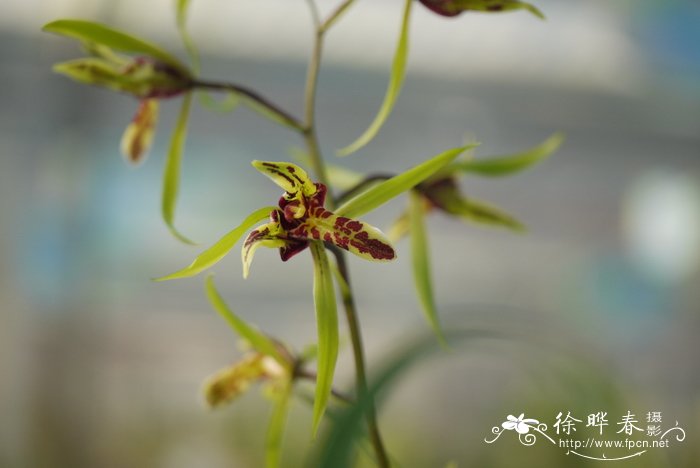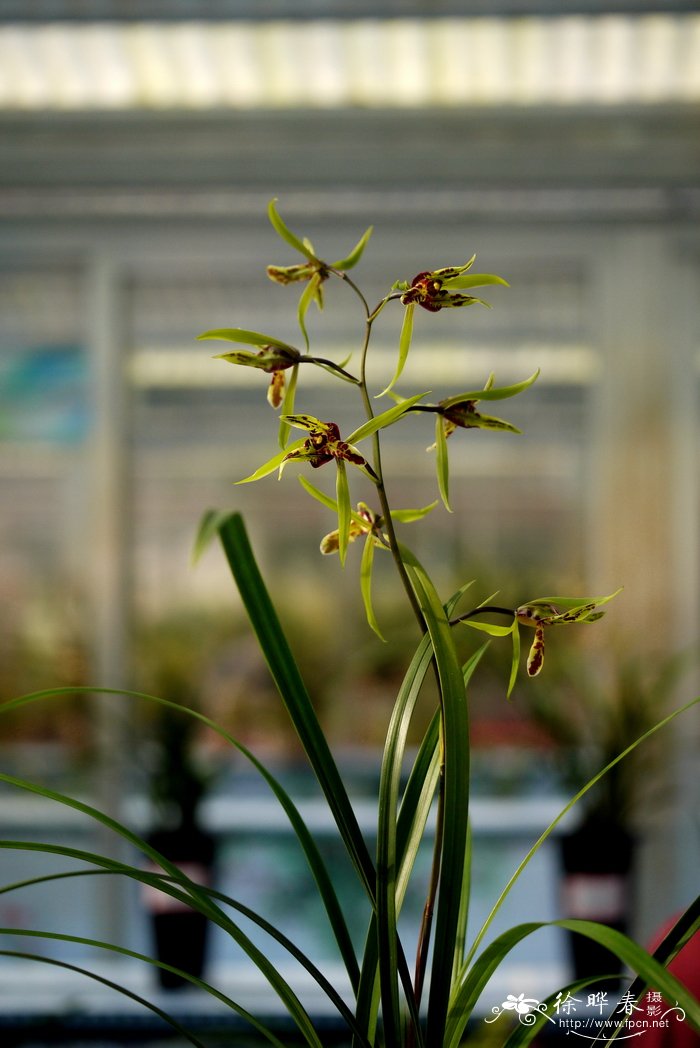寒兰Cymbidium kanran
中文名(Chinese Name):寒兰
学名(Scientific Name):Cymbidium kanran Makino
英文名(English Common Name):
别名(Chinese Common Name):
异名(Synonym):Cymbidium linearisepalum f. atrovirens Yamam. Cymbidium linearisepalum var. atropurpureum (Yamam.) Masam. Cymbidium kanran var. aestivale Y. S. Wu Cymbidium sinokanran var. atropurpureum T. K. Yen Cymbidium linearisepalum Yamam. Cymbidium linearisepalum var. atrovirens (Yamam.) Masam. Cymbidium purpureo-hiemale Hayata Cymbidium misericors var. oreophilum (Hayata) Hayata Cymbidium misericors var. oreophyllum (Hayata) Hayata Cymbidium oreophyllum Hayata Cymbidium sinokanran T. K. Yen Cymbidium tosyaense Masam. Cymbidium linearisepalum f. atropurpureum Yamam. Cymbidium oreophilum Hayata Cymbidium purpureohiemale Hayata Cymbidium kanran f. purpurascens Makino Cymbidium kanran var. purpureohiemale (Hayata) S.S.Ying
科属(Family & Genus):兰科(Orchidaceae)兰属
形态特征(Description):地生或附生植物;假鳞茎卵球形至狭卵形,长5-9厘米,宽2.5-4厘米,包藏于叶基之内。叶6-9枚,带形,长60-90厘米,宽7-12毫米,先端渐尖,关节位于距基部7.5-10厘米处。花葶近直立或外弯,长28-90厘米,较粗壮;总状花序具4-9朵或更多的花;花苞片近三角形,长3-5毫米,但下部的可达11-15毫米;花梗和子房长3-4厘米;花直径6-7厘米,无香气;萼片与花瓣白色或略带淡粉红色,有时基部有红点,唇瓣白色,侧裂片上通常有紫红色斑点和条纹,中裂片中部至基部黄色,亦有少数斑点与斑纹;萼片椭圆状倒卵形,长3-3.5厘米,宽1-1.4厘米;侧萼片略斜歪;花瓣狭倒卵形,长2.8-3厘米,宽1-1.2厘米;唇瓣近卵圆形,略短于花瓣,3裂,基部与蕊柱合生达2-3毫米;侧裂片上有极细的小乳突与细毛,边缘无明显缘毛;中裂片稍外弯,基部与中部有一片密短毛区,其余部分有小乳突,边缘皱波状;唇盘上有3条纵褶片,左右2条从基部延伸至中裂片基部,顶端略膨大,中央1条较短,均密生短毛;蕊柱长2.4-2.8厘米,向前弯曲,两侧具翅,腹面基部有短毛;花粉团2个,三角形至近四方形。花期11-12月。
分布(Distribution):产我国中南部,生于400~2400米林下、溪谷旁或稍荫蔽、湿润、多石之土壤上。日本和朝鲜半岛也有分布。
用途(Use):
引自中国植物志英文版:FOC Vol. 25 Page 263, 275, 276
Cymbidium kanran Makino, Bot. Mag. (Tokyo). 16: 10. 1902.
寒兰 han lan| Orchidaceae | Cymbidium
Cymbidium kanran var. aestivale Y. S. Wu; C. kanran var. purpureohiemale (Hayata) S. S. Ying; C. linearisepalum Yamamoto; C. linearisepalum f. atropurpureum Yamamoto; C. linearisepalum var. atropurpureum (Yamamoto) Masamune; C. linearisepalum f. atrovirens Yamamoto; C. linearisepalum var. atrovirens (Yamamoto) Masamune; C. misericors Hayata var. oreophilum (Hayata) Hayata; C. nigrovenium Z. J. Liu & J. N. Zhang; C. oreophilum Hayata; C. purpureohiemale Hayata; C. sinokanran T. K. Yen; C. sinokanran var. atropurpureum T. K. Yen; C. tosyaense Masamune.
Plants terrestrial, autotrophic. Pseudobulbs narrowly ovoid, 2-4 × 1-1.5 cm, enclosed in leaf bases. Leaves 3-5(-7), deep green, lorate, 40-70 × 0.9-1.7 cm, thinly leathery, articulate 4-5 cm from base, apical margin often finely toothed. Inflorescence arising from base of pseudobulb, erect, 25-60(-80) cm; rachis laxly 5-12-flowered; floral bracts narrowly lanceolate, mostly 15-26 × 1-2 mm, though basal one to 40 mm. Flowers usually strongly fragrant, variable in color; pedicel and ovary 20-25(-30) mm; sepals and petals pale yellowish green with purplish red striations; lip yellowish, mottled purplish red. Sepals sublinear or linear-lanceolate, 30-50 × 3.5-5(-7) mm, apex acuminate. Petals narrowly ovate or ovate-lanceolate, 20-30 × 5-10 mm; lip subovate, 20-30 mm, not fused to basal margins of column, obscurely 3-lobed; lateral lobes erect, loosely clasping column; mid-lobe recurved, oblong-ovate, 11-16 × 8-12 mm, margin slightly incised; disk minutely papillate-pubescent, with 2 longitudinal lamellae extending from base of lip to base of mid-lobe; lamellae convergent toward apices and forming a short tube. Column slightly arcuate, 10-17 mm, narrowly winged; pollinia 4, in 2 pairs, broadly ovoid. Capsule narrowly ellipsoid, ca. 45 × 18 mm. Fl. Aug-Dec, fr. Feb-Apr. 2n = 40, 41.
Forests, streamsides, shaded places, moist and rocky slopes; 400-2400 m. Anhui, N Fujian, Guangdong, Guangxi, Guizhou, Hainan, Hunan, Jiangxi, Sichuan, Taiwan, SE Xizang, Yunnan, Zhejiang [S Japan, S Korea].
Cymbidium ×nishiuchianum Makino ex J. M. H. Shaw (Orchid Rev. 110: 13. 2002) was recently described as a hybrid of C. goeringii and C. kanran.

 (责任编辑:徐晔春)
(责任编辑:徐晔春)
学名(Scientific Name):Cymbidium kanran Makino
英文名(English Common Name):
别名(Chinese Common Name):
异名(Synonym):Cymbidium linearisepalum f. atrovirens Yamam. Cymbidium linearisepalum var. atropurpureum (Yamam.) Masam. Cymbidium kanran var. aestivale Y. S. Wu Cymbidium sinokanran var. atropurpureum T. K. Yen Cymbidium linearisepalum Yamam. Cymbidium linearisepalum var. atrovirens (Yamam.) Masam. Cymbidium purpureo-hiemale Hayata Cymbidium misericors var. oreophilum (Hayata) Hayata Cymbidium misericors var. oreophyllum (Hayata) Hayata Cymbidium oreophyllum Hayata Cymbidium sinokanran T. K. Yen Cymbidium tosyaense Masam. Cymbidium linearisepalum f. atropurpureum Yamam. Cymbidium oreophilum Hayata Cymbidium purpureohiemale Hayata Cymbidium kanran f. purpurascens Makino Cymbidium kanran var. purpureohiemale (Hayata) S.S.Ying
科属(Family & Genus):兰科(Orchidaceae)兰属
形态特征(Description):地生或附生植物;假鳞茎卵球形至狭卵形,长5-9厘米,宽2.5-4厘米,包藏于叶基之内。叶6-9枚,带形,长60-90厘米,宽7-12毫米,先端渐尖,关节位于距基部7.5-10厘米处。花葶近直立或外弯,长28-90厘米,较粗壮;总状花序具4-9朵或更多的花;花苞片近三角形,长3-5毫米,但下部的可达11-15毫米;花梗和子房长3-4厘米;花直径6-7厘米,无香气;萼片与花瓣白色或略带淡粉红色,有时基部有红点,唇瓣白色,侧裂片上通常有紫红色斑点和条纹,中裂片中部至基部黄色,亦有少数斑点与斑纹;萼片椭圆状倒卵形,长3-3.5厘米,宽1-1.4厘米;侧萼片略斜歪;花瓣狭倒卵形,长2.8-3厘米,宽1-1.2厘米;唇瓣近卵圆形,略短于花瓣,3裂,基部与蕊柱合生达2-3毫米;侧裂片上有极细的小乳突与细毛,边缘无明显缘毛;中裂片稍外弯,基部与中部有一片密短毛区,其余部分有小乳突,边缘皱波状;唇盘上有3条纵褶片,左右2条从基部延伸至中裂片基部,顶端略膨大,中央1条较短,均密生短毛;蕊柱长2.4-2.8厘米,向前弯曲,两侧具翅,腹面基部有短毛;花粉团2个,三角形至近四方形。花期11-12月。
分布(Distribution):产我国中南部,生于400~2400米林下、溪谷旁或稍荫蔽、湿润、多石之土壤上。日本和朝鲜半岛也有分布。
用途(Use):
引自中国植物志英文版:FOC Vol. 25 Page 263, 275, 276
Cymbidium kanran Makino, Bot. Mag. (Tokyo). 16: 10. 1902.
寒兰 han lan| Orchidaceae | Cymbidium
Cymbidium kanran var. aestivale Y. S. Wu; C. kanran var. purpureohiemale (Hayata) S. S. Ying; C. linearisepalum Yamamoto; C. linearisepalum f. atropurpureum Yamamoto; C. linearisepalum var. atropurpureum (Yamamoto) Masamune; C. linearisepalum f. atrovirens Yamamoto; C. linearisepalum var. atrovirens (Yamamoto) Masamune; C. misericors Hayata var. oreophilum (Hayata) Hayata; C. nigrovenium Z. J. Liu & J. N. Zhang; C. oreophilum Hayata; C. purpureohiemale Hayata; C. sinokanran T. K. Yen; C. sinokanran var. atropurpureum T. K. Yen; C. tosyaense Masamune.
Plants terrestrial, autotrophic. Pseudobulbs narrowly ovoid, 2-4 × 1-1.5 cm, enclosed in leaf bases. Leaves 3-5(-7), deep green, lorate, 40-70 × 0.9-1.7 cm, thinly leathery, articulate 4-5 cm from base, apical margin often finely toothed. Inflorescence arising from base of pseudobulb, erect, 25-60(-80) cm; rachis laxly 5-12-flowered; floral bracts narrowly lanceolate, mostly 15-26 × 1-2 mm, though basal one to 40 mm. Flowers usually strongly fragrant, variable in color; pedicel and ovary 20-25(-30) mm; sepals and petals pale yellowish green with purplish red striations; lip yellowish, mottled purplish red. Sepals sublinear or linear-lanceolate, 30-50 × 3.5-5(-7) mm, apex acuminate. Petals narrowly ovate or ovate-lanceolate, 20-30 × 5-10 mm; lip subovate, 20-30 mm, not fused to basal margins of column, obscurely 3-lobed; lateral lobes erect, loosely clasping column; mid-lobe recurved, oblong-ovate, 11-16 × 8-12 mm, margin slightly incised; disk minutely papillate-pubescent, with 2 longitudinal lamellae extending from base of lip to base of mid-lobe; lamellae convergent toward apices and forming a short tube. Column slightly arcuate, 10-17 mm, narrowly winged; pollinia 4, in 2 pairs, broadly ovoid. Capsule narrowly ellipsoid, ca. 45 × 18 mm. Fl. Aug-Dec, fr. Feb-Apr. 2n = 40, 41.
Forests, streamsides, shaded places, moist and rocky slopes; 400-2400 m. Anhui, N Fujian, Guangdong, Guangxi, Guizhou, Hainan, Hunan, Jiangxi, Sichuan, Taiwan, SE Xizang, Yunnan, Zhejiang [S Japan, S Korea].
Cymbidium ×nishiuchianum Makino ex J. M. H. Shaw (Orchid Rev. 110: 13. 2002) was recently described as a hybrid of C. goeringii and C. kanran.
踩一下[1]

顶一下[3]